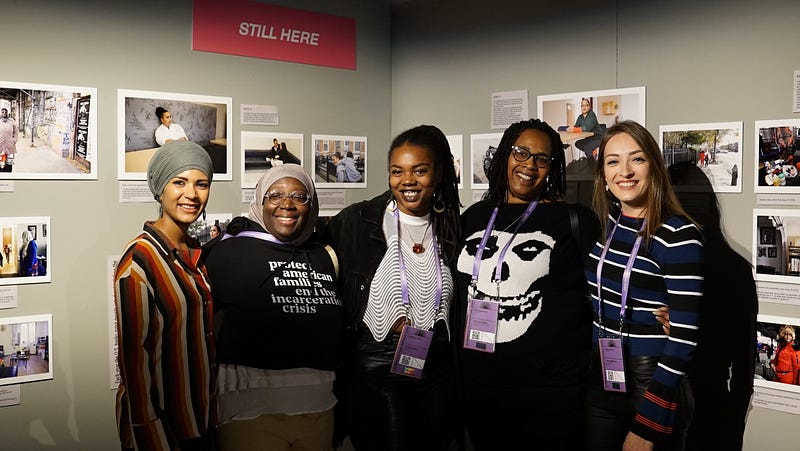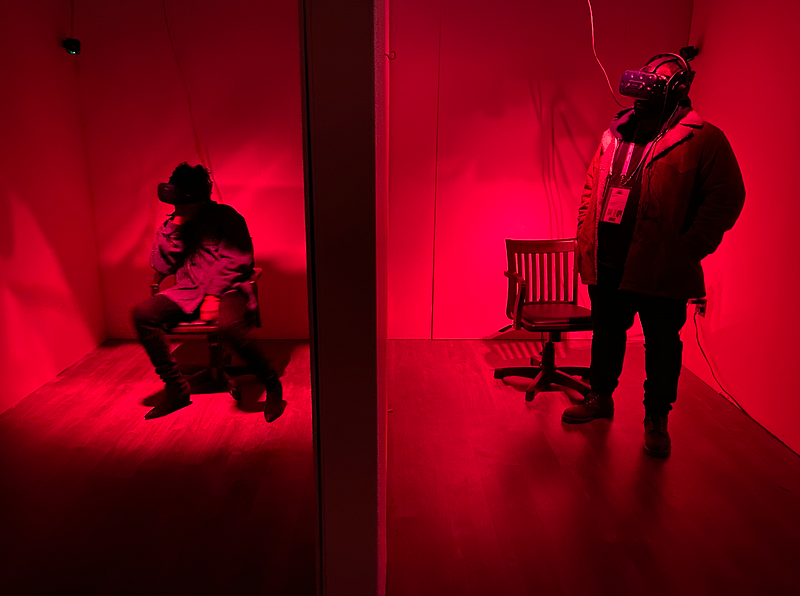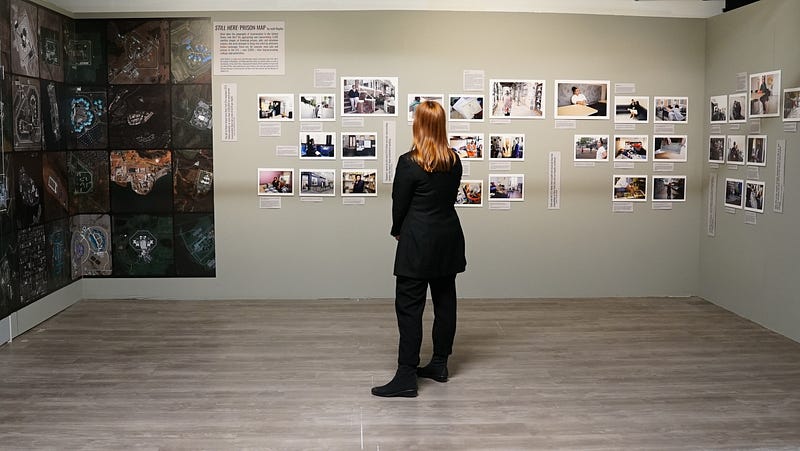An interview with Zahra Rasool, creator of VR film Still Here
Still Here is an immersive, multimedia installation exploring incarceration, erasure, and gentrification through the lens of a fictional character named Jasmine Smith who returns to Harlem, NYC after 15 years in prison.
Crafted in collaboration with formerly incarcerated women from Women’s Prison Association, the experience comprises three parts — interactive virtual reality (VR), audio with augmented reality (AR) and a photo exhibit (Six Women and Prison Map). Learn more about the creation process here.
I spoke with Zahra Rasool, the lead artist of the VR/AR component of Still Here. Rasool is the editorial lead of AJ Contrast, Al Jazeera’s media innovation studio, where her team addresses stories about conflict and inequality.
This conversation has been edited and condensed for space and clarity.
 (From left
to right): Zahra Rasool, lead artist and co-creator, Elaine Daly, collaborator and WPA student,
Le’Asha Julius, lead actor, Tamanika Evans, collaborator and WPA student, and Viktorija Mickute,
producer and creative director
(From left
to right): Zahra Rasool, lead artist and co-creator, Elaine Daly, collaborator and WPA student,
Le’Asha Julius, lead actor, Tamanika Evans, collaborator and WPA student, and Viktorija Mickute,
producer and creative directorCould you tell me about the process and methodology that went into making Still Here? How did the project come about?
At AJ Contrast, our editorial revolves around telling stories of marginalized communities and people of color that are hit hardest by conflict, but bringing them into the collaboration into a storytelling process so that we’re telling stories with them rather than about them.
I started researching gentrification in New York City because it’s a topic a lot of young people around the world can relate to. The more we researched gentrification, I realized we couldn’t tell the story without talking about mass incarceration. We also wanted to tell the story from the lens of women of color, particularly Black women, because in the discourse on incarceration, they are the ones that are often left out.
Why did your team decide to tell this story in XR?
The story is set in a part of Harlem that’s being gentrified. I thought it would be great to take somebody to that location in Harlem to see the changes and the impacts of gentrification unfold in front of them. It’s a story informing what tool that we’re going to use in order to tell it.
What was fascinating to me was this idea that you can give people the freedom to walk around or interact, but that freedom can also be restrained and controlled. When people are incarcerated, their movements and choice are restricted, but even when they are outside of prison and they’re trying to re-enter society, their ability to reenter is also severely restricted because of the challenges.
 Naima Ramos
Chapman, writer and director of 360 videos and Carvell Wallace, writer of the AR story, watching
Still Here VR
Naima Ramos
Chapman, writer and director of 360 videos and Carvell Wallace, writer of the AR story, watching
Still Here VRHow would you say this project addresses the limitations of the medium for storytelling?
We’ve used the limitations to add more meaning to the story. In the VR experience, once you enter the house, if you’re not able to walk from the room to the kitchen, that is annoying. Now, in the context of this story, the fact that you can’t just walk from the bedroom into the kitchen is meaningful because your actions and choices are controlled for a specific reason.
What motivated the use of the photography exhibit featuring your collaborators?
At Sundance, only four people could do the AR experience at a time, and only two people could do the VR experience, whereas the photo exhibit is accessible to anybody walking through the space. It was a story we just needed to get out. We used XR to tell it, for different reasons. In the VR and AR, you follow this character called Jasmine Smith, which is a composite character based on the real-life experiences of several formerly incarcerated women. But at the end of the day, it is still scripted. With the photo exhibit, we wanted to be able to show you these stories are actually real people. These are real people’s lives.
 The
photography exhibit of Still Here at Sundance Film Festival.
The
photography exhibit of Still Here at Sundance Film Festival.One woman featured in the exhibit had difficulty adapting to changes in technology after she was released from prison. How was working with women who likely never used XR before? What was learned through this process?
None of the women had ever been in a headset before. I did the first workshop with around 11 women, all of whom were part of the Women’s Prisons Association. And my first session with them was showing videos inside the headset.
It was very important for me to be able to explain to them what it is and how the filming happens. How is this camera different from a linear camera? How does a post-process work? I just wanted them to have that information. A couple of them were also on the set where we filmed the 360 videos. So, they saw the production process of the filming. I think the more information we gave them and the more we included them in the production of Still Here, the stronger our piece became because they were constantly giving input feedback.
How did your team establish trust and ensure you connect with the audience of this piece?
We knew from the start that this is not a story that people from the community are going to be the primary audience of. But we still created it with the community as the center of the piece. If I felt I told a story that resonated with the community, everyone else would find some meaning in it. But if I failed the community whose story we were telling, if I failed those formerly incarcerated women of color who we’ve been working with then the story would also be meaningless to anybody else.
I don’t think what message the white audience from a gentrified community will get was the focus of my creation at all. I think having the eleven women included in the production process helped the story resonate with others in their community. I remember the time when we first showed it to one of the women, Michelle, her reaction was very powerful. A lot of them were crying. There was a woman who said: “That didn’t happen to me, but it could’ve happened to me.” We were aiming to do the story justice.
Do you have any recommendations for storytellers to stay accountable?
I would emphasize making sure that the people whose stories you’re telling are involved in the process from the very start. They were your best check to hold you responsible, if you’re open to it. The creative team of Still Here were directly connected to the issue. Naima Ramos Chapman, who wrote and directed the 360 videos, is from Brooklyn and her father spent 15 years in prison. Carvell Wallace, who wrote the AR script, spent over 15 years working with incarcerated people.
I do want to acknowledge the fact that I’m not a native New Yorker, nor am I impacted by incarceration. And so, for me, it became even more important to make sure that when I am telling somebody else’s story, I’m holding myself accountable.
How is confinement not only defined by the physical boundaries of the prison but also what happens outside of it?
After prison, people are coming into a society where they don’t have adequate resources. Many don’t have housing and it is incredibly difficult to reconnect with families. So many of these women have had their children separated from them. Employment opportunities are very hard to find. Mental health and other health issues are not adequately addressed in jails and prisons. And when they are released, there is no support to rehabilitate them. So you’re coming into a system that’s completely broken. And that’s the reason why we’re seeing high recidivism rates. There is a reason for that.
Immerse is an initiative of the MIT Open DocLab and The Fledgling Fund, and it receives funding from Just Films | Ford Foundation and the MacArthur Foundation. IFP is our fiscal sponsor. Learn more here. We are committed to exploring and showcasing media projects that push the boundaries of media and tackle issues of social justice — and rely on friends like you to sustain ourselves and grow. Join us by making a gift today.